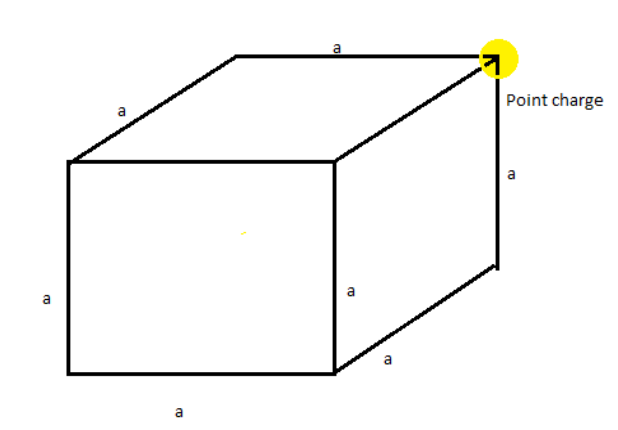
What is the flux through a cube of side ‘a’ if a point charge q is at one of its corners ?
A) \[\dfrac{q}{{{\varepsilon _\circ }}}\]
B) \[\dfrac{q}{{2{\varepsilon _\circ }}}\]
C) \[\dfrac{{2q}}{{{\varepsilon _\circ }}}\]
D) \[\dfrac{q}{{8{\varepsilon _\circ }}}\]
Answer
510.3k+ views
Hint: Electric flux is the rate of flow of the electric field through a given area. According to gauss law, the electric flux through a closed surface is equal to \[\dfrac{q}{{{\varepsilon _\circ }}}\], if q is the charge enclosed in it.
In case if a charge is placed at one of the corners of the cube then the amount of charge enclosed in it is eighth part of the charge so the flux is also the eighth part of \[\dfrac{q}{{{\varepsilon _\circ }}}\].
Formula used:
Gauss law: According to gauss law :- If a charge “q ” is enclosed in a closed surface then the net flux emerging out of the closed surface is \[\dfrac{q}{{{\varepsilon _\circ }}}\]. Gauss law is only applicable for closed bodies.
Complete step by step solution:
According to gauss law, the electric flux through a closed surface is equal to \[\dfrac{q}{{{\varepsilon _\circ }}}\], if q is the charge enclosed in it.

If the charge ‘q ’is placed at one of the corners of the cube, it will be divided into 8 such cubes. Therefore, electric flux through the one cube is the eighth part of \[\dfrac{q}{{{\varepsilon _\circ }}}\].
So electric flux (\[\varphi \]) is equal to \[\dfrac{q}{{8{\varepsilon _\circ }}}\].
Hence option (D) is the correct answer.
Gauss law is one of the four Maxwell’s equations which form the basis of classical electrodynamics.
Note: Electric flux has SI units of volt metres ( V m).
Electric flux is the rate of flow of electric field through a given area. Electric flux is proportional to the number of electric field lines going through a virtual surface. Gauss law can be used to derive the coulomb’s law and vice-versa.
In case if a charge is placed at one of the corners of the cube then the amount of charge enclosed in it is eighth part of the charge so the flux is also the eighth part of \[\dfrac{q}{{{\varepsilon _\circ }}}\].
Formula used:
Gauss law: According to gauss law :- If a charge “q ” is enclosed in a closed surface then the net flux emerging out of the closed surface is \[\dfrac{q}{{{\varepsilon _\circ }}}\]. Gauss law is only applicable for closed bodies.
Complete step by step solution:
According to gauss law, the electric flux through a closed surface is equal to \[\dfrac{q}{{{\varepsilon _\circ }}}\], if q is the charge enclosed in it.

If the charge ‘q ’is placed at one of the corners of the cube, it will be divided into 8 such cubes. Therefore, electric flux through the one cube is the eighth part of \[\dfrac{q}{{{\varepsilon _\circ }}}\].
So electric flux (\[\varphi \]) is equal to \[\dfrac{q}{{8{\varepsilon _\circ }}}\].
Hence option (D) is the correct answer.
Gauss law is one of the four Maxwell’s equations which form the basis of classical electrodynamics.
Note: Electric flux has SI units of volt metres ( V m).
Electric flux is the rate of flow of electric field through a given area. Electric flux is proportional to the number of electric field lines going through a virtual surface. Gauss law can be used to derive the coulomb’s law and vice-versa.
Recently Updated Pages
Wheatstone Bridge Explained: Working, Formula & Uses

Young’s Double Slit Experiment Derivation Explained

JEE Atomic Structure and Chemical Bonding important Concepts and Tips

JEE Amino Acids and Peptides Important Concepts and Tips for Exam Preparation

Electricity and Magnetism Explained: Key Concepts & Applications

Chemical Properties of Hydrogen - Important Concepts for JEE Exam Preparation

Trending doubts
JEE Main 2026: Application Form Open, Exam Dates, Syllabus, Eligibility & Question Papers

Derivation of Equation of Trajectory Explained for Students

Hybridisation in Chemistry – Concept, Types & Applications

Understanding the Angle of Deviation in a Prism

Understanding Collisions: Types and Examples for Students

How to Convert a Galvanometer into an Ammeter or Voltmeter

Other Pages
JEE Advanced Marks vs Ranks 2025: Understanding Category-wise Qualifying Marks and Previous Year Cut-offs

Ideal and Non-Ideal Solutions Explained for Class 12 Chemistry

Degree of Dissociation: Meaning, Formula, Calculation & Uses

Understanding Electromagnetic Waves and Their Importance

Understanding the Electric Field of a Uniformly Charged Ring

Understanding Average and RMS Value in Electrical Circuits




